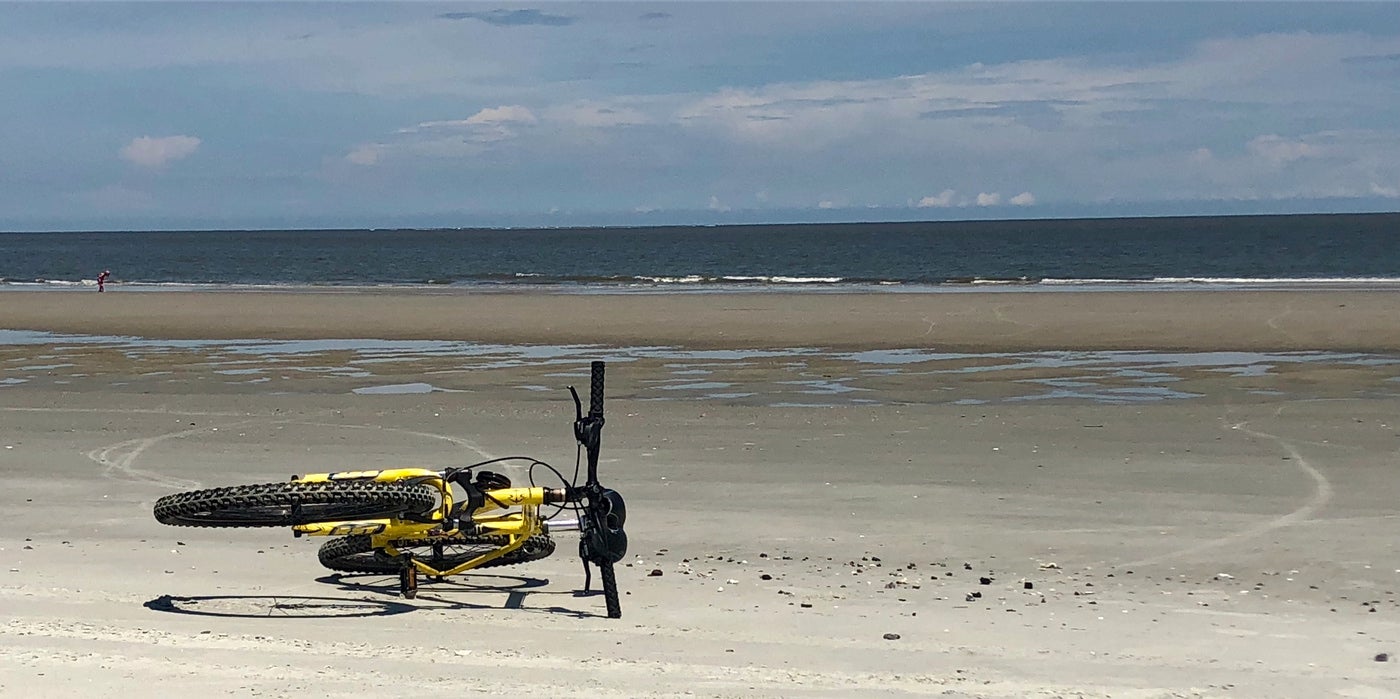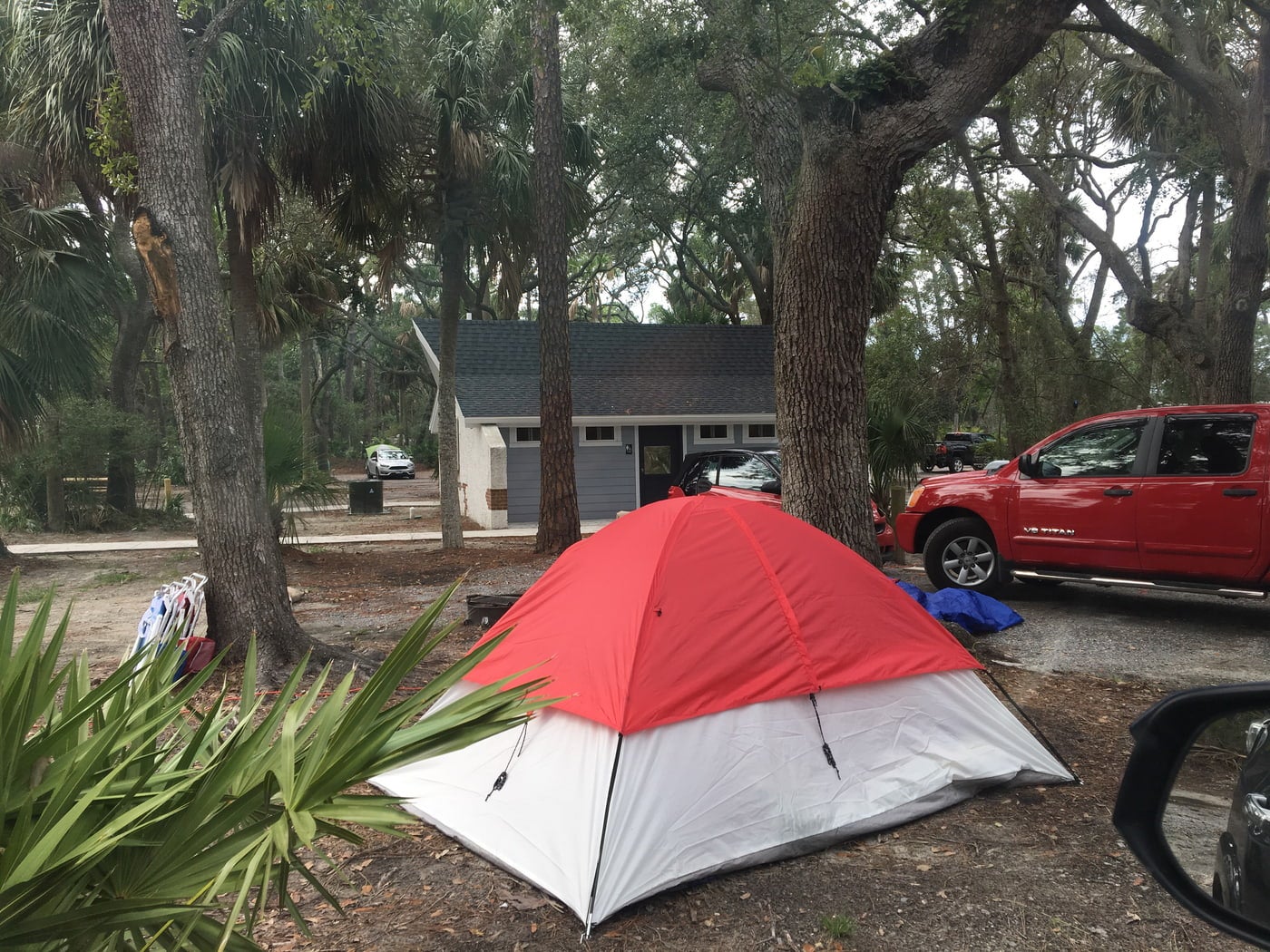This time of year most of the country is firmly in the grasp of our latest polar vortex. In contrast, I decided it was a good time to head south for an adventure. What I found was a stunning collage of tropical paradise and eastern forest in South Carolina.
Palm trees, sandy beaches, and the region’s iconic Spanish moss exist among towering pines and live oaks. All creating a diverse environment unlike any other along the nearly 30,000 miles of Atlantic shoreline.
Get Lost and Find Yourself at Hunting Island State Park

Image from The Dyrt camper Shari G.
Stepping barefoot onto the beach quickly reminded of the simple joy of warm sand under your feet. I stood on an isolated coast, without another human in sight. It was a peaceful and humbling experience.
Walking along the shore, you’ll be hard-pressed to find better evidence of the perpetual battle that is land vs. sea. The sudden and dramatic meeting of forest and ocean is unlike anything I have experienced.
Explore the Dense Vegetation Of A Maritime Forest

Image from The Dyrt camper Michele B.
Venturing onto some of the interior trails within Hunting Island had me feeling as though I had entered Jurassic Park. Dense populations of Saw, Cabbage, and Dwarf palmettos, serve as a welcome habitat to numerous creatures.
Large pines provide a worthy vantage for the many birds of prey which call them home. Hiking alongside the tidal lagoon, numerous songs of woodland birds serenaded me.
“If a dinosaur stepped out from the side of a trail,” writes The Dyrt camper Shelly S., in her review of Hunting Island State Park, “it would not be out of place!”
Ascend The Hunting Island Lighthouse

Images from The Dyrt Campers Michele B. and Katrin M.
South Carolina’s only lighthouse accessible to the public provides a fascinating piece of history for Hunting Island visitors to enjoy. First erected in the 1850s, the original lighthouse was destroyed by Confederate troops during the Civil War. Due to the encroaching coastline, the new building was moved to the center of the island in 1889.
Those who embark up the 167 spiral stairs to the lightkeeper’s observation deck are well rewarded. At the top you’ll get a spectacular view of the coast and nearby barrier islands (Fripp, St. Helena, and Edisto). You’ll notice how close the beach is to a structure that used to be the center of the island!
The foundation of the lightkeeper’s house and numerous support buildings from the late 1880s still remain. Hunting Island State Park visitors will find informative plaques, reminding them isolating nature of being a lighthouse keeper near the turn of the 20th century.
Enjoy Equestrian Beach Access
Embark on a memorable ride atop your favorite horse for a unique way to experience all 5 miles of pristine coast along Hunting Island. During the months of December, January, and February the park opens access to the beach for all equestrian riders.
Remember to call the park first at 843-838-2011, however, as a permit is required.
Hike, Bike, or Run

Image from The Dyrt camper Michele B.
Meandering alongside a tidal lagoon, through a semi-tropical maritime forest, into a saltwater marsh, and to the banks of a freshwater lagoon are nearly nine miles of maintained trail, suitable for hiking and biking.
Trail runners will love the smooth, compacted gravel surface found on most of the trails. The ability to run through a wild landscape, with solid surface absorption, and without the need to closely mind your footing is a great recipe for putting in some memorable miles.
Become An Expert Birder
Hunting Island State Park is a birding paradise with many shorebird populations peaking during the winter season migration. Pelicans, egrets, herons, ibis, osprey, skimmers, oystercatchers, terns, and wood storks are common sightings amongst the salt marshes and tidal lagoon. Forested sections feature numerous woodland birds singing songs throughout the day.
Look To The Star-Filled Sky

One of the most awe-inspiring, starry, night skies that I have ever experienced was while walking along the Hunting Island campground beach one night. The open view to the sky that a shoreline provides, combined with the remote nature of Hunting Island, away from the light pollution of civilization, creates incredible stargazing opportunities.
For a memorable sunrise, hike the Nature Center Scenic Trail (0.7 easy miles) out to the southern stretch of coast along Hunting Island. It leads to the most remote area of the park and contains an impressive tree graveyard to explore.
For the best sunsets, make your way onto the Marsh Boardwalk Trail (0.3 miles), a designated National Recreational Trail, which places you amongst the marsh grasses and tidal wetlands of the salt marsh.
Where To Camp at Hunting Island

Image from The Dyrt camper Shelly S.
Your only option for camping on Hunting Island is at the Hunting Island State Park Campground, which is located adjacent to the beach for convenient access to tidepooling or beach exploration. There are numerous sites where you can park your RV or set up your tent with a view of the ocean, and they all have electrical and water hookups.
If you’re planning to spend more time exploring the charm of nearby Beaufort, SC consider staying at Tuck In The Woods Campground, which is located on St. Helena Island.
With my brief adventure onto Hunting Island coming to a close, I made the early-bird decision to hike out onto the beach, in darkness, along the southern expanse of the island, and enjoy one last sunrise from this isolated coast. Completely alone, standing amidst a tangled, mystical world, I listened to the sounds of the ocean waves, watched a blue heron enjoy breakfast along the lagoon banks (a mere 70 yards behind me), and revelled in the beauty of a starry sky slowly filling with the orange glow of the rising sun.
Feeling renewed, refreshed, and content that I hadn’t dealt with a single thought of freezing hair or frozen jeans for three days, I knew that Hunting Island had just become a place that I would not soon forget.
Related Campgrounds:
- Pirateland Campground, Myrtle Beach, SC
- Lake Keowee Campgrounds, Keowee-Toxaway State Park, SC
- Hunting Island Camping, St Helena Island, SC
- Lakewood Camping Resort, Myrtle Beach, SC
- Edisto Beach State Park, Edisto Island, SC
Popular Articles:
Articles on The Dyrt Magazine may contain links to affiliate websites. The Dyrt receives an affiliate commission for any purchases made by using such links at no additional cost to you the consumer.



